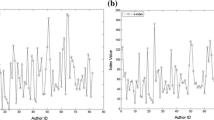Abstract
The assessment of individual researchers using bibliometric indicators is more complex than that of a region, country or university. For large scientific bodies, averages over a large number of researchers and their outputs is generally believed to give indication of the quality of the research work. For an individual, the detailed peer evaluation of his research outputs is required and, even this, may fail in the short term to make a final, long term assessment of the relevance and originality of the work. Scientometrics assessment at individual level is not an easy task not only due to the smaller number of publications that are being evaluated, but other factors can influence significantly the bibliometric indicators applied. Citation practices vary widely among disciplines and sub disciplines and this may justify the lack of good bibliometric indicators at individual level. The main goal of this study was to develop an indicator that considers in its calculation some of the aspects that we must take into account on the assessment of scientific performance at individual level. The indicator developed, the h nf index, considers the different cultures of citation of each field and the number of authors per publication. The results showed that the h nf index can be used on the assessment of scientific performance of individual researchers and for following the performance of a researcher.



Similar content being viewed by others
References
Ahmed, T., Johnson, B., Oppenheim, C., & Peck, C. (2004). Highly cited old papers and the reasons why they continue to be cited. Part II. The 1953 Watson and Crick article on the structure of DNA. Scientometrics, 61(2), 147–156.
Aksnes, D. W. (2003). A macro study of self-citation. Scientometrics, 56(2), 235–246.
Alonso, S., Cabrerizo, F. J., Herrera-Viedma, E., & Herrera, F. (2010). Hg-index: A new index to characterize the scientific output of researchers based on the H- and G-indices. Scientometrics, 82(2), 391–400. doi:10.1007/s11192-009-0047-5.
Batista, P. D., Campiteli, M. G., Kinouchi, O., & Martinez, A. S. (2006). Is it possible to compare researchers with different scientific interests? Scientometrics, 68(1), 179–189.
Bonzi, S., & Snyder, H. W. (1991). Motivations for citation—a comparison of self citation and citation to others. Scientometrics, 21(2), 245–254.
Brooks, T. A. (1985). Private acts and public objects—an investigation of citer motivations. Journal of the American Society for Information Science, 36(4), 223–229.
Brooks, T. A. (1986). Evidence of complex citer motivations. Journal of the American Society for Information Science, 37(1), 34–36.
Burrell, Q., & Rousseau, R. (1995). Fractional counts for authorship attribution—a numerical study. Journal of the American Society for Information Science, 46(2), 97–102.
Claro, J., & Costa, C. A. V. (2010). A made-to-measure indicator for cross-disciplinary bibliometric ranking of researchers performance. Scientometrics. doi:10.1007/s11192-010-0241-5.
Cole, J. R., & Cole, S. (1973). Social stratification in science. Chicago: The University of Chicago Press.
Egghe, L. (2006). Theory and practise of the g-index. Scientometrics, 69(1), 131–152. doi:10.1007/s11192-006-0144-7.
Egghe, L. (2008). Mathematical theory of the h- and g-index in case of fractional counting of authorship. Journal of the American Society for Information Science and Technology, 59(10), 1608–1616. doi:10.1002/asi.20845.
Frost, C. O. (1989). The literature of online public-access catalogs, 1980–85—an analysis of citation patterns. Library Resources & Technical Services, 33(4), 344–357.
Glanzel, W., & Thijs, B. (2004). Does co-authorship inflate the share of self-citations? Scientometrics, 61(3), 395–404.
Jin, B. H., Liang, L. M., Rousseau, R., & Egghe, L. (2007). The R- and AR-indices: Complementing the h-index. Chinese Science Bulletin, 52(6), 855–863. doi:10.1007/s11434-007-0145-9.
Prathap, G. (2010). Is there a place for a mock h-index? Scientometrics, 84(1), 153–165. doi:10.1007/s11192-009-0066-2.
Rons, N., & Amez, L. (2009). Impact vitality: An indicator based on citing publications in search of excellent scientists. Research Evaluation, 18(3), 233–241. doi:10.3152/095820209x470563 (Article).
Schreiber, M. (2009). A case study of the modified hirsch index h(m) accounting for multiple coauthors. Journal of the American Society for Information Science and Technology, 60(6), 1274–1282. doi:10.1002/asi.21057.
van Hooydonk, G. (1997). Fractional counting of multiauthored publications: Consequences for the impact of authors. Journal of the American Society for Information Science, 48(10), 944–945.
van Raan, A. F. J. (2004). Sleeping beauties in science. Scientometrics, 59(3), 467–472.
Vieira, E. S., & Gomes, J. A. N. F. (2009). A comparison of Scopus and Web of science for a typical university. Scientometrics, 81(2), 587–600. doi:10.1007/s11192-009-2178-0.
Vieira, E. S., & Gomes, J. A. N. F. (2010). Citations to scientific articles: Its distribution and dependence on the article features. Journal of Informetrics, 4(1), 1–13. doi:10.1016/j.joi.2009.06.002.
Author information
Authors and Affiliations
Corresponding author
Appendix 1
Appendix 1
Calculation of the h index for the scenarios presented in Table 2 (see Tables 8, 9, 10 and 11).
Rights and permissions
About this article
Cite this article
Vieira, E.S., Gomes, J.A.N.F. An impact indicator for researchers. Scientometrics 89, 607–629 (2011). https://doi.org/10.1007/s11192-011-0464-0
Received:
Published:
Issue Date:
DOI: https://doi.org/10.1007/s11192-011-0464-0




